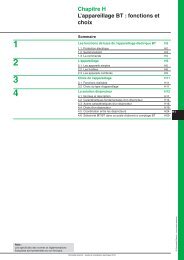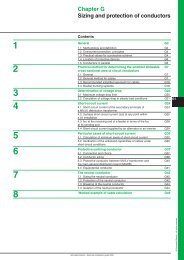Electrical Installation Guide 2009 - the global specialist in energy ...
Electrical Installation Guide 2009 - the global specialist in energy ...
Electrical Installation Guide 2009 - the global specialist in energy ...
- No tags were found...
You also want an ePaper? Increase the reach of your titles
YUMPU automatically turns print PDFs into web optimized ePapers that Google loves.
B - Connection to <strong>the</strong> MV publicdistribution network3 Protection aspectIndirect-contact protection or fault protectionA person touch<strong>in</strong>g <strong>the</strong> metal envelope of an apparatus with a faulty <strong>in</strong>sulation, asdescribed above, is said to be mak<strong>in</strong>g an <strong>in</strong>direct contact.An <strong>in</strong>direct contact is characterized by <strong>the</strong> fact that a current path to earth exists(through <strong>the</strong> protective earth<strong>in</strong>g (PE) conductor) <strong>in</strong> parallel with <strong>the</strong> shock currentthrough <strong>the</strong> person concerned.Case of fault on L.V. systemExtensive tests have shown that, provid<strong>in</strong>g <strong>the</strong> potential of <strong>the</strong> metal envelope is notgreater than 50 V with respect to earth, or to any conductive material with<strong>in</strong> reach<strong>in</strong>gdistance, no danger exists.Indirect-contact hazard <strong>in</strong> <strong>the</strong> case of a MV faultIf <strong>the</strong> <strong>in</strong>sulation failure <strong>in</strong> an apparatus is between a MV conductor and <strong>the</strong> metalenvelope, it is not generally possible to limit <strong>the</strong> rise of voltage of <strong>the</strong> envelope to50 V or less, simply by reduc<strong>in</strong>g <strong>the</strong> earth<strong>in</strong>g resistance to a low value. The solution<strong>in</strong> this case is to create an equipotential situation, as described <strong>in</strong> Sub-clause 1.1“Earth<strong>in</strong>g systems”.B173.2 Protection of transformer and circuitsGeneralThe electrical equipment and circuits <strong>in</strong> a substation must be protected <strong>in</strong> orderto avoid or to control damage due to abnormal currents and/or voltages. Allequipment normally used <strong>in</strong> power system <strong>in</strong>stallations have standardized short-timewithstand rat<strong>in</strong>gs for overcurrent and overvoltage. The role of protective scheme isto ensure that this withstand limits can never be exceeded. In general, this meansthat fault conditions must be cleared as fast as possible without miss<strong>in</strong>g to ensurecoord<strong>in</strong>ation between protective devices upstream and downstream <strong>the</strong> equipementto be protected. This means, when <strong>the</strong>re is a fault <strong>in</strong> a network, generally severalprotective devices see <strong>the</strong> fault at <strong>the</strong> same time but only one must act.These devices may be:b Fuses which clear <strong>the</strong> faulty circuit directly or toge<strong>the</strong>r with a mechanical tripp<strong>in</strong>gattachment, which opens an associated three-phase load-break switchb Relays which act <strong>in</strong>directly on <strong>the</strong> circuit-breaker coilTransformer protectionStresses due to <strong>the</strong> supply networkSome voltage surges can occur on <strong>the</strong> network such as :b Atmospheric voltage surgesAtmospheric voltage surges are caused by a stroke of lightn<strong>in</strong>g fall<strong>in</strong>g on or near anoverhead l<strong>in</strong>e.b Operat<strong>in</strong>g voltage surgesA sudden change <strong>in</strong> <strong>the</strong> established operat<strong>in</strong>g conditions <strong>in</strong> an electrical networkcauses transient phenomena to occur. This is generally a high frequency or dampedoscillation voltage surge wave.For both voltage surges, <strong>the</strong> overvoltage protection device generally used is avaristor (Z<strong>in</strong>c Oxide).In most cases, voltage surges protection has no action on switchgear.Stresses due to <strong>the</strong> loadOverload<strong>in</strong>g is frequently due to <strong>the</strong> co<strong>in</strong>cidental demand of a number of smallloads, or to an <strong>in</strong>crease <strong>in</strong> <strong>the</strong> apparent power (kVA) demand of <strong>the</strong> <strong>in</strong>stallation,due to expansion <strong>in</strong> a factory, with consequent build<strong>in</strong>g extensions, and so on. Load<strong>in</strong>creases raise <strong>the</strong> temperature of <strong>the</strong> wir<strong>in</strong>gs and of <strong>the</strong> <strong>in</strong>sulation material. Asa result, temperature <strong>in</strong>creases <strong>in</strong>volve a reduction of <strong>the</strong> equipment work<strong>in</strong>g life.Overload protection devices can be located on primary or secondary side of <strong>the</strong>transformer.The protection aga<strong>in</strong>st overload<strong>in</strong>g of a transformer is now provided by a digital relaywhich acts to trip <strong>the</strong> circuit-breaker on <strong>the</strong> secondary side of <strong>the</strong> transformer. Suchrelay, generally called <strong>the</strong>rmal overload relay, artificially simulates <strong>the</strong> temperature,tak<strong>in</strong>g <strong>in</strong>to account <strong>the</strong> time constant of <strong>the</strong> transformer. Some of <strong>the</strong>m are able totake <strong>in</strong>to account <strong>the</strong> effect of harmonic currents due to non l<strong>in</strong>ear loads (rectifiers,computer equipment, variable speed drives…).This type of relay is also able topredict <strong>the</strong> time before overload tripp<strong>in</strong>g and <strong>the</strong> wait<strong>in</strong>g time after tripp<strong>in</strong>g. So, this<strong>in</strong>formation is very helpful to control load shedd<strong>in</strong>g operation.© Schneider Electric - all rights reservedSchneider Electric - <strong>Electrical</strong> <strong>in</strong>stallation guide <strong>2009</strong>
















